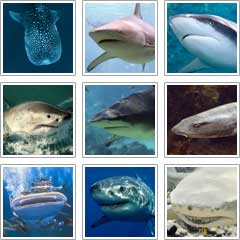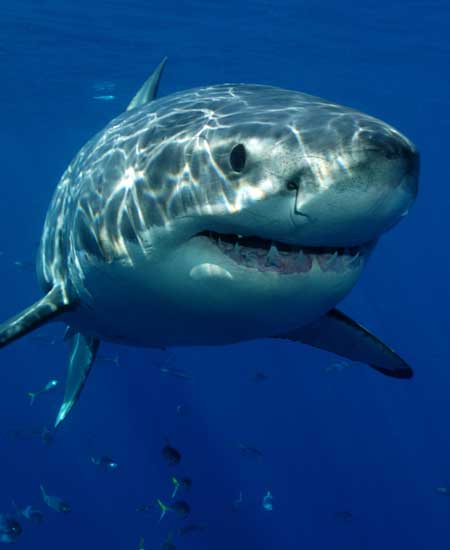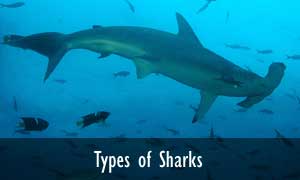Shark Information
Shark information, habitat, distribution, feeding, reproduction, senses, anatomy, communication, evolution and social structure.
Read More…
Shark Species
Types of sharks like the Great white shark, tiger shark, whale shark, bull shark, hammerhead shark, goblin shark, mako shark, and many more.
Read More…
Shark Conservation
There are several species of sharks with the great danger of become extinct if they are not conserved properly.
Read More…
Shark Information, Anatomy, Habitat, Feeding, Reproduction and Types of Sharks. Facts about Great White Sharks, Tiger Sharks, Bull Sharks, Whale Sharks, Bull Shark, Hammerhead Shark, Mako Shark and more.

Introduction to Sharks
Sharks are a large group of fish that have inhabited the oceans for over 400 million years, even before dinosaurs populated our planet. They belong to the superorder Selachimorpha, and modern sharks have specific characteristics like a cartilaginous skeleton, five or six pairs of gills and several rows of teeth.
Ancient Sharks lived before land vertebrates populated the Earth and even before many plant species developed on continents. While they were very different from those found today, sharks have been on this planet for a long time.
The shark species as we know them have been around for 100 million years; this means that they were dwelling the oceans when dinosaurs were roaming the land. This record-breaking survival cannot be anything but astonishing, developing an anatomy during this time which only has improved over those million years of evolution.
These unique animals cause all kind of human feelings: fear, awe, curiosity, respect and love. They have been widely represented in the popular culture as ruthless predators, which is the main reason why they cause all these different reactions. However, the truth is pretty different. Sharks are complex and fascinating creatures, which are distant from the general representation. Even more, many species are docile and harmless.
Learning about the world of sharks, knowing their features, discovering their secrets, and recognizing their importance in our world is the first step to their conservation. When most people think about sharks, they have a mental picture of a deadly predator. However, sharks are far more than this and play a vital role in the oceans and nature.
EVOLUTION OF SHARKS.
Some shark fossils discovered date back as far as 420-450 million years.
Their evolution has produced several species with different sizes, anatomies, habits and behaviors.
Their classification according to the features such as the fin types, spine, snout and body shape determine the genus and family of each species. For example, the great white shark has the mouth behind its eyes and a large dorsal fin by the middle of its body and a second dorsal fin behind. An angel shark, on the other hand, has a couple of fins in the dorsal area near the tail and a flat nose with the mouth underneath.
SHARK BEHAVIOR.
The evolutionary features of sharks, not only defined their look but also the adaptations they have to survive in the wild. There are three types of sharks according to the place they live which is closely related to the form and functions of their body. Some sharks dwell at the surface of the ocean and move slowly, other sharks inhabit the pelagic zone and have amazing swimming capabilities and some others stay at the seafloor, in the benthic zone, and move slowly searching for food on the sea floor.
According to those areas where sharks live, there are also specific ways of surviving. Therefore in each of these parts, the prey behave in different ways which led to the developing of the hunting skills that they acquired.
TAXONOMY OF SHARKS.
Sharks are 470 species belonging to the superorder Selachimorpha. The scientific classification of all sharks is as follows:
Kingdom: Animalia
Phylum: Chordata
Class: Chondrichthyes
Subclass: Elasmobranchii
Superorder: Selachimorpha
The classification continues with eight orders, organized in 37 families which include all the species. Let’s take a closer look at each of these eight orders and the families that belong to each of them:
1. Hexanchiformes.
This classification includes the most primitive sharks, those with six or seven gill slits, a dorsal fin, and lack of nictitating membranes in their eyes.
Two families. Six species.
Frilled sharks. (2 species)
Cow sharks. (4 species)
2. Squaliformes.
This order includes species characterized by having two dorsal fins and five gill slits.
Seven families. 126 species.
Gulper sharks. (18 species)
Kitefin sharks. (9 species)
Bramble sharks. (2 species)
Lantern sharks. (44 species)
Rough sharks. (5 species)
Sleeper sharks. (18 species)
Dogfish sharks. (30 species)
3. Squatiniformes.
This order includes sharks with a wide flat body and pectoral fins, characteristics that make them similar to rays.
One family. 21 Species.
Angel sharks. (21 species)
4. Pristiophoriformes.
The species belonging to this order have a long snout and serrated teeth.
One family. 8 Species.
Sawsharks. (8 species)
5. Heterodontiformes.
It is an order of small sized species with spikes on the front part of their dorsal fins.
One family. 9 Species.
Bullhead sharks. (9 species)
6. Orectolobiformes.
The species that belong to this order are also called carpet sharks and have two dorsal fins without spines, and some species feature patterns decorating their skin.
Seven families. 44 Species.
Blind sharks. (2 species)
Nurse sharks. (4 species)
Bamboo sharks. (16 species)
Wobbegong sharks. (12 species)
Collared carpet sharks. (8 species)
Whale sharks. (1 species)
Zebra sharks. (1 species)
7. Carcharhiniformes.
It is the largest order, and its members are also called ground sharks. They have nictitating membranes in their eyes, anal fin, and five gill slits.
Eight families. 280 Species.
Requiem sharks. (62 species)
Weasel sharks. (8 species)
Barbeled houndshark. (1 species)
Finback catsharks. (7 species)
False catsharks. (4 species)
Catsharks. (150 species)
Hammerhead sharks. (8 species)
Houndsharks. (40 species)
8. Lamniformes.
Members of this order have two dorsal fins, an anal fin, five gill slits and a large mouth that extends behind the eyes.
Seven families. 16 species.
Thresher sharks (4 species)
Basking sharks (1 species)
Mackerel sharks (5 species)
Megamouth sharks (1 species)
Goblin sharks (1 species)
Sand sharks (3 species)
Crocodile sharks (1 species)
Types of Sharks
Facts about Sharks
Types of Sharks
Great White Shark Facts
MYTHS ABOUT SHARKS YOU SHOULD DISMISS
People think of sharks as ruthless predators that will attack humans at first sight. However, this myth is not accurate. In fact, according to the international shark attack file since 1581 there have been 828 unprovoked attacks so far, resulting in 160 casualties, meaning that there were less than two attacks on average each year. However, it is evident that not all attacks are registered. To have a better idea, during 2015 there were 98 unprovoked shark attacks which resulted in 6 deaths. Contrary to popular belief, only 34 shark species are involved in such attacks and therefore are dangerous to humans, among them, the tiger shark, the bull shark or the great white shark.
The concept of sharks, as “man-eaters” lurking beneath the legs of any swimmer that goes into the ocean, remains in our minds despite the time, but it is wrong. Dismisses this idea!
Sharks are not vicious creatures looking that you become their next meal, nor they are always searching for people. Attacks on humans are extremely rare, reaching on average of ten deaths by year, and only 34 species have ever attacked a human. To have a fair perspective, the men’s best friend, the dog, kills nearly 25,000 people annually, around the world.
Other popular myths to dismiss are:
1. Sharks are predators that feed on animals such as fish, seals, and whales.
Partially right, but remember that not all sharks eat large animals. Some, like whale sharks and megamouth sharks, feed on plankton. In these cases, teeth are small and not used to consume or catch their food.
2. All sharks are large and have very sharp teeth.
Among the large variety of species, there are many with an anatomy different than the torpedo-shaped body and huge teeth like the great white shark. Many have a small, thin or elongated body, with tiny teeth.
3. Products made with shark fins are healthy and have medicinal and aphrodisiac properties.
There is no scientific evidence supporting this myth. In fact, the unrestricted capture of sharks to get their fins is a big problem for shark conservation.
Shark Facts Video
Shark Pictures

Frequently Asked Questions About Sharks
- How Are Whale Sharks Endangered
The whale shark is targeted by commercial and artisan fisheries. This has put them in the list of endangered species. Although the worldwide population is unknown, the reduction in sightings have put them in a… - How Big Is The Biggest Recorded Whale Shark
The Guinness Book of Records has the Worlds Largest fish (a Whale Shark) recorded as 12.65 metres which is 41 feet 6 inches. However, there are versions that whale sharks could reach 60 feet, but… - How Big Is The Shark Brain
While brain size cannot be generalized to every shark species, some of them have a Y shaped brain with two bulbs, measuring about 2 feet (60 centimeters) Some writers have said that the shark brain… - How Do Sharks Breed
While some species breed differently. Mating in sharks has been rarely observed, but most species do it while they swim parallel to each other and the male inserts a clasper into female’s oviduct. - How Do Sharks Communicate
There is not solid evidence on how sharks communicate, however there is a great belief that the extraordinary senses developed by sharks are involved in any communication between sharks, if any… - How Do Sharks Find Their Food
Sharks are provided with several extraordinary senses that help them find their prey. Probably this developed and accurate senses has made them very successful for 400 million years. Usually they use their electrosense system to…
- How Do Sharks Know When Something Is Food Or Not
Studies have proved that shark senses are fully responsible for shark hunting. They commonly use the electrosense for location, even at long distances.The lateral line sense detects water vibrations usual to most living things… - How Do Sharks Reproduce
There are three different ways in which every shark species reproduce.While mating in sharks has been rarely observed, most species do it while they swim parallel to each other and the male inserts a… - How Do Sharks Use Static Electricity
Sharks have electroreceptor organs called Ampullae of Lorenzini.They are able to detect the electromagnetic field generated by all living things.This is used by sharks to find its prey. Sharks have from hundreds to… - How Does A Shark Breathe
As other fishes, sharks breathe by extracting oxygen when seawater pass through their gills. Shark gills are just behind shark head and they are not specially covered like in most fish. Water pass thorough their… - How Does A Whale Shark Reproduce
Whale shark reproduction process is not known in detail. Initially, whale sharks were believed to be oviparus, as some eggs were found in the bottom of the ocean. Later it was proved that such eggs… - How Does Global Warming Affect Sharks
Fishes included sharks are cold blooded animals, therefore and excessive increase of water temperature could even kill by itself some shark species. However collateral effects will make even more damage to them. These collateral consequences…




